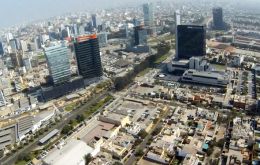MercoPress. South Atlantic News Agency
Tag: Latam
-
Friday, October 14th 2016 - 05:48 UTC
Falklands considers air link with Brazil including a monthly stopover in Argentina

“Is a monthly stopover in Argentina too high a price to pay for a direct weekly flight to Sao Paulo, the biggest flight hub in South America,” is the question we all have to ask ourselves, said lawmaker MLA Mike Summers this week as he set out the situation and options available to progress and develop the Falkland Islands’ economy.
-
Tuesday, April 21st 2015 - 01:16 UTC
World Bank warns Latin America about permanent slowdown in the absence of structural reform

In its latest semiannual report, “Latin America Treads a Narrow Path to Growth: The Slowdown and its Macroeconomic Challenges,” the World Bank´s Office of the Chief Economist for Latin America and the Caribbean forecasts a fourth year of slow growth for the region.
-
Wednesday, March 11th 2015 - 06:32 UTC
Latam's low indebtedness level opens the way for anti-cyclical fiscal policies to spur economies, says ECLAC

Latin America's public debt decreased in the last 25 years, according to a report from the Economic Commission for Latin America and the Caribbean (ECLAC). External public debt fell from 70% to 16% of the region’s GDP highlighted the fiscal analysis of the region, rising to near 40% when domestic public debt is added to calculations.
-
Friday, October 10th 2014 - 05:01 UTC
Latam headed for a third year of foreign trade stagnation, reports ECLAC

Latin America and the Caribbean's foreign trade will experience its third year of stagnation in 2014, because of minimal growth in exports and a slight decline in imports, the Economic Commission for Latin America and the Caribbean (ECLAC) reported on Thursday.
-
Wednesday, October 8th 2014 - 04:05 UTC
World Bank: end of boom doesn’t have to mean a bust for the poor in Latin America

During the recent commodity boom, Latin America and the Caribbean proved that growth could be pro-poor and help fuel tremendous social progress. Now as growth slows regionally and beyond, it is critical to consider what will shore up economic activity while ensuring the poor won't stay behind.
-
Tuesday, October 7th 2014 - 06:16 UTC
Ambassador Castro criticizes 'holdouts' and thanks UK unions' support for Argentina

Argentine ambassador in the United Kingdom, Alicia Castro has fiercely criticized the conduct of holdout investors and thanked UK unions for their support in the dispute with 'vulture funds', during an address to the British umbrella trade union UNITE.
-
Wednesday, August 27th 2014 - 06:11 UTC
Some 200 million people remain vulnerable in Latam despite lesser poverty

More than 56 million people have been lifted out of poverty in Latin America and the Caribbean in recent years, according to the United Nations Development Program (UNDP). But despite the progress, it warned that some 200m people, or 37.8% of the population, remained vulnerable.
-
Tuesday, June 3rd 2014 - 05:26 UTC
Latin America losing its competitive edge as demand for commodities slows down

The United States ranks as the most competitive country in the world in a survey of 60 countries by IMD, a leading global business school in Switzerland. The survey finds Europe is recovering some of its competitive edge, while emerging economies, particularly in Latin America are struggling to hold their own.
-
Friday, May 23rd 2014 - 23:42 UTC
ECLAC/ILO anticipate less job creation in Latam as the overall economy slows down

The economic scenario for 2014, with an estimated average growth rate of 2.7%, is far from encouraging for the evolution of the Latin American regional labor market and presents major challenges for labor market policy, said the Economic Commission for Latin America and the Caribbean (ECLAC) and the International Labor Organization (ILO) in a new joint report released this week.
-
Monday, May 12th 2014 - 23:51 UTC
Lima ranks as the Latin American with best reputation for making business

Lima, capital of Peru outstands as the leading Latin American city to make business, followed by Santiago de Chile, Buenos Aires, Argentina and Sao Paulo, Brazil, although these last two actually dropped from the previous ranking, according to an annual list made by the Bogotá Rosario University.
